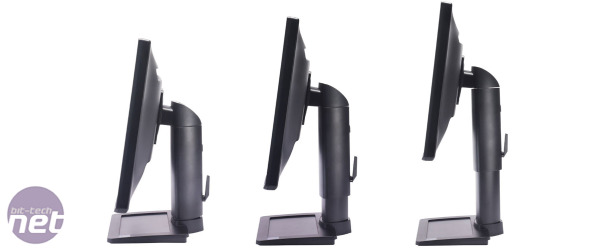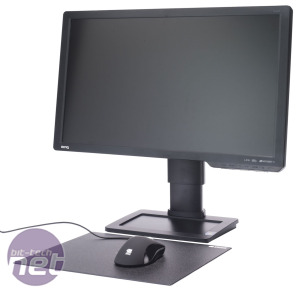Stand and Image Quality
We’re not convinced that the two pro-gamers had anything to do with the housing of the BenQ, as it’s utilitarian in appearance. Going by Homer’s bubble car, maybe that’s a good thing. While the height adjustment requires wrestling with a catch, there’s 130mm of play and you can also rotate, pivot and swivel the screen. On the underside are HDMI, D-Sub and DVI inputs, but the headphone mini-jack on the side is largely useless – there’s no microphone connection for a gaming headset, and you have to transfer audio to the screen via HDMI in the first place.By default, the XL2410T has a very blue colour cast, making images look positively hypothermic. We reduced this by loweri ng the blue colour channel from 100 to 89 via the OSD menu, but the row of OSD buttons made this job trickier than necessary. We also turned off the ridiculous 10,000,000:1 dynamic contrast ratio (the static 1,000:1 ratio is plenty). The screen has a few image modes, from FPS to Movie to Eco, but they all look horrible – FPS mode returns the screen to its excessively wintry colour balance, while Eco dims the 300cd/m2 backlight to an unusable low level in order to save just 12W of power consumption.
While most TN screens struggle to discern dark greys from black, the XL2410T was less able at this than most screens, meaning that shadows looked flat and lifeless in games and videos; the Serenity HD trailer didn’t look as rich as usual, for example.
Oddly, the XL2410T gave a yellow tint to explosions and skin tones too, a downside that wasn’t balanced out by the optical illusion that poor contrast in dark tones gives images a more solid feel. However, the XL2410T lacked the sparkle of IPS-based screens such as the £200 ViewSonic VP2365wb – the images looked fine, but nothing more. At least the 120Hz refresh rate and 2ms response time helped moving objects on the XL2410T to remain solid and crisp.
Conclusion
BenQ might call the XL2410T its first gaming-specific screen, but its design is even more focused than this – it’s the first screen made for professional-level gamers, and primarily FPS pro-gamers.However, while the 120Hz refresh rate and 2ms response time help to keep even fast-moving images sharp, the XL2410T has merely adequate image quality and handles dark shades poorly. This Zowie Special Edition also represents very poor value, even if you're after a new mouse and mouse mat; it costs £75 more than the standard XL2410T, with that extra cash bagging you a basic gaming mouse and mat. We bet you've already got perfectly good examples of both, especially if you're interested in buying a screen primarily for gaming on.
The ViewSonic VP2365wb has richer image quality, an adjustable stand and is more than £80 cheaper than the standard XL2410T, and a whopping £155 less than the XL2410T Zowie Special Edition. Comparatively, the ViewSonic is a steal.
- Image Quality
- x
- x
- x
- x
- x
- x
- -
- -
- -
- -
- 6/10
- Features
- x
- x
- x
- x
- x
- x
- x
- x
- -
- -
- 8/10
- Value
- x
- x
- -
- -
- -
- -
- -
- -
- -
- -
- 2/10
- Overall
- x
- x
- x
- x
- x
- -
- -
- -
- -
- -
- 5/10

MSI MPG Velox 100R Chassis Review
October 14 2021 | 15:04












Want to comment? Please log in.